I would like to share an IMPORTANT BIKE SETUP CONCEPT with you that greatly impacts how you ride. Read on to learn if Your Handlebar Height is Sabotaging Your Ride.
Background:
I’ve been experimenting with handlebar height for years, but since writing this article four years ago, I have been really paying attention to my bar height.
As I go from bike to bike (everyday bike, enduro bike, downhill bike, ebike) I have found that even a 5mm difference in handlebar height affects my body position.
Take into account that all four bikes have very similar geometry, the same length stem, the same handlebars, the same grips, and the same handlebar roll.
This article assumes you already know what
- width bar you like,
- what bar roll you like,
- what lever placement you like, and
- what grips you like.
For present purposes we have to assume these things are sorted out as I was taught never to make more than one change at a time.
If you make two changes at once (change your bar height and bar width at the same time), you won’t know what caused it to feel better or worse after the changes.
Why your handlebar height is important:
Precise handlebar height is more important than I realized! I made a small handlebar height adjustment, and it ended up sabotaging my racing and riding for six weeks.
Many of my students’ handlebars are too high and often we lower them 10-50mm, to get them in a better, more confident position.
Often, bikes come from the shop in the most comfortable position with 20-50mm of spacers under the stem and riser bars (bars that rise 15 to 40mm higher than the stem). This feels good in the parking lot, and while seated and pedaling on mellow terrain, but when you want to ride more demanding trails, it can get in the way.
What happens if your bars are too high:
In my courses, I explain that if your bars are too high, it makes riding more difficult. When climbing with your handlebars too high, it is hard to hinge forward enough to keep the front wheel on the ground on steep climbs, even when you have slid your weight all the way forward on the saddle.
With high handlebars, wheelies and manuals are harder to do and tend to put you in a “hanging off the handlebars” body position with your weight too far back while descending.
What is the goal of finding the right height:
The GOAL of finding the right handlebar height is to find a height that puts you in an athletic, centered, neutral, and hinged body position when standing and descending while not compromising your climbing body position.
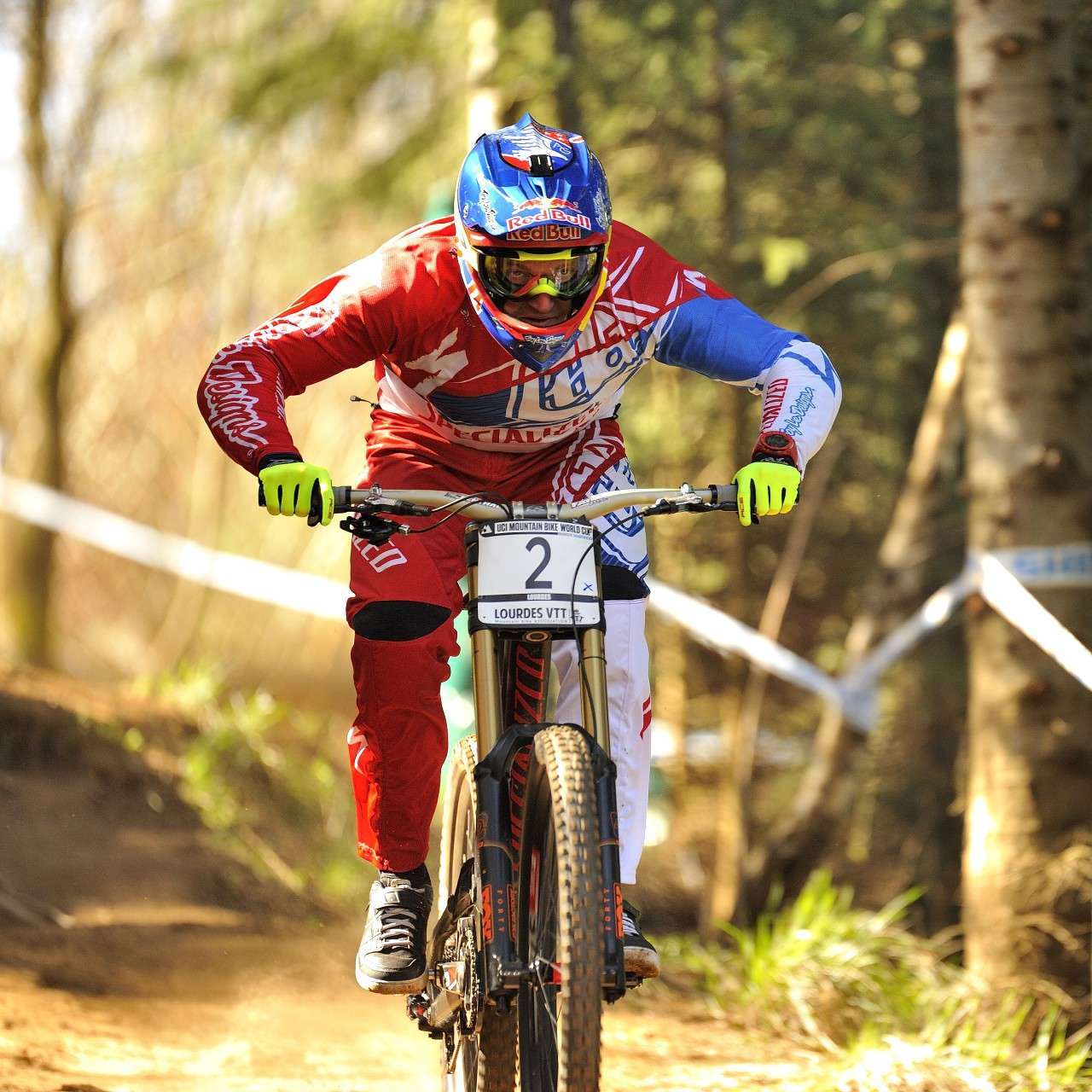
Aaron Gwin in a hinged-at-the-hips-flat-back riding position. (Photo by Downhill911)
Reaching this goal has become challenging as our wheels get bigger and forks get taller with more suspension travel. For people approximately 5’6” and shorter, it was much easier to get the bar height right on a 26” wheeled bike with 75mm of suspension travel than a 29er with 130-170mm of travel.
Before we get further with bar height;
Let me explain an important riding concept:
Riding confidently and on the offense (riding with a focus on accomplishing what you WANT to do instead of focusing on what you DON’T WANT to do) is one of the most important aspects of mountain biking.
Focusing on getting to the bottom of the descent smoothly or quickly instead of focusing on not crashing is paramount to riding at your best.
It turns out that HANDLE HEIGHT affects more than just your body position! A mere 16mm rise in bar height (that I thought was going to take the stress off my shoulders and allow me to look further ahead) not only hurt my position but it killed my confidence.
That 16mm rise put me in the “hanging off the back of your bike” position.
What I teach:
In my courses, I teach that too-high handlebars make it harder to stay centered while descending.
If you think about it, that is a very defensive posture, leaning back away from danger.
Being upright decreases our stability as well as our ability to stay neutral (where we can react/respond better to what the trail throws at us).
Check out my Body position and Fundamental Movement Video Tutorial
Consequences of having your bars too high:
That defensive posture put me on, well, the defensive, and four years ago, I spent the week of the National Championships riding scared (I managed to win but was disappointed in my nervous riding). Let me tell you, this is a vicious cycle!
Start riding on the defensive, and you start making mistakes. Those mistakes scare you, so you feel like you can’t ride well – further shaking your confidence.
Of course, I attributed this to a crash I had three weeks before, not to the seemingly insignificant change in bar height. This did feel a little weird immediately, but change always feels weird, so I thought I would get used to it.
After racing the National Championships and then another regional race, I was really frustrated with how I was riding.
However, I realized my handlebar height might be the culprit, so I lowered the bars 10mm by removing two headset spacers under the stem.
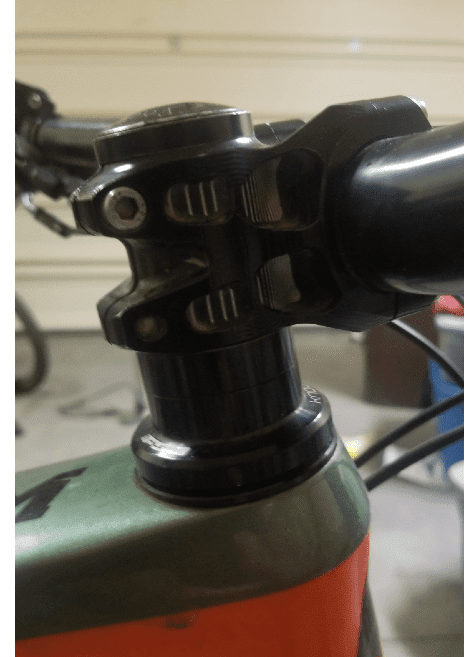
The difference in confidence was immediate! With the first run with lower bars, I was riding much more aggressively.
Until this experiment, it would have been hard for me to believe 10mm in bar height could make that much of a difference, but it did! It forced me to hinge a little more and more importantly, it centered me over the bike in a much more stable and aggressive position.
I often tell students that their handlebars are too high when they are obviously 20-60mm too high, but now I know to stress experimenting with bar height more for all my students. If 10mm can make a huge difference in body position, confidence, and control, imagine what 15-60mm could do.
Too high a handlebar height puts us in an upright and slightly back-of-center position: not quite in balance, not neutral, and ultimately a defensive position.
In short: Experiment with your handlebar height. Go as low as you can go with your current bars and see what happens.
Many riders (those under 5’10 riding 29ers and under 5’8″ on 27.5 bikes) should try a bar with no rise.
For taller riders:
Your handlebar height can help you achieve the hinged-at-the-hips-flat-back descending position like Amaury Pierron pictured below.
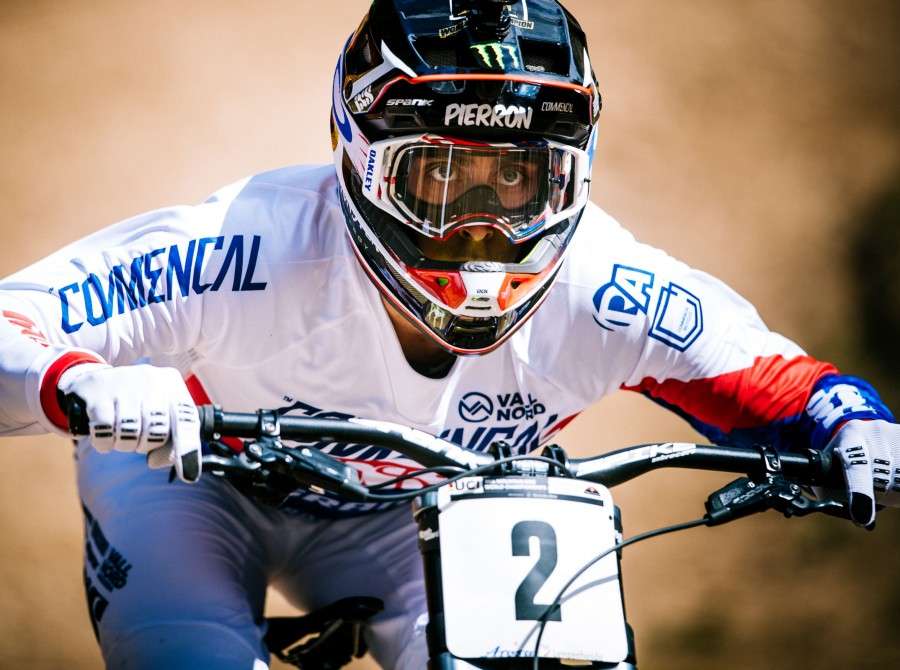
Amaury Pierron hinged-at-the-hips-flat-back riding position
For shorter riders:
For shorter riders, you will usually find a slightly less hinged position feels better like Jackson Goldstone in this photo:
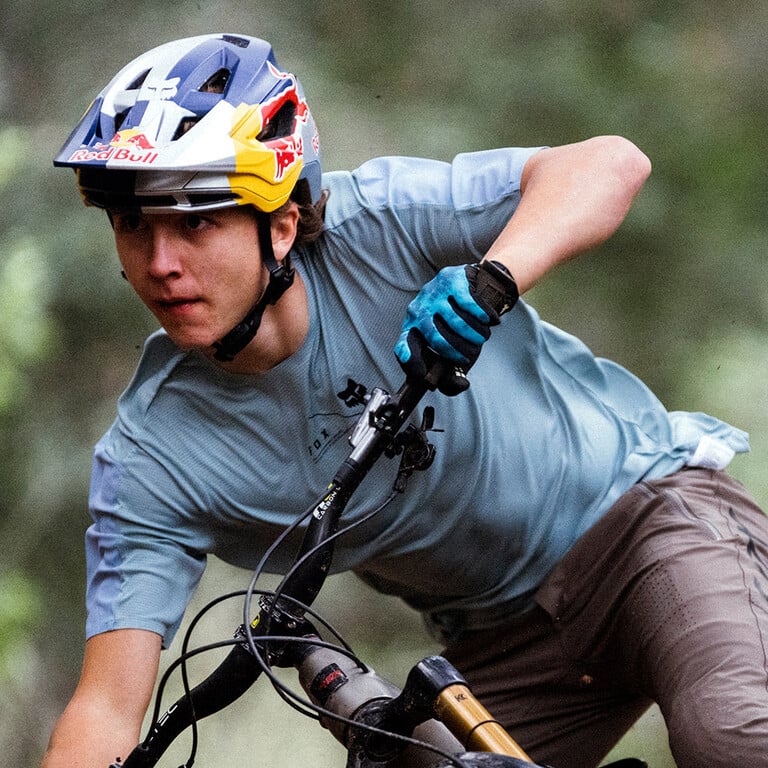
Jackson Goldstone imagine courtesy of Fox Racing
What is the formula:
I wish there were a simple formula for bar height. For me, it is when my bars are about 3″ above my knee when standing and coasting with my pedals level.
For shorter people, it can be above their belly button when they are standing on the pedals.
I have been searching for that formula for years but there are just too many variables. Three people of the exact same height are likely to have different limb lengths, shoulder widths, differing amounts of core strength and hip mobility, etc and be on bikes with different headtube heights and frame reach measurements.
One of my coaches taught me that, instead of looking for a formula, you should focus on whether you are in an athletic position. If you are not in an athletic position, stop and make adjustments to get yourself in that position.
Again, what is your GOAL:
It is to have your bars low enough for climbing and to put you in an athletic, hinged-at-the-hips position when standing and descending.
Too low and it may hurt your back and make it hard to look ahead.
Too high and you may struggle with keeping your front wheel on the ground during steep climbs and/or find yourself hanging off the back of your bike while descending.
The old rule of thumb that your handlebars should be level with your saddle (at full climbing height) to 3 inches below your saddle (at full climbing height) is a great place to start.
In general, the taller you are, the more drop-from-saddle-height-to-
Many riders who are under 5’6” will find it hard to even get the handlebars level with the saddle on a 29r. Pro XC racer, Chloe Woodruff who at 5’2”, runs a negative rise stem to get her bars lower (as do many riders under 5’6”, especially if they ride 29er’s).
How to adjust your bike:
Many/most mountain bikes are sold with handlebars as high as the steerer tube will allow. This is usually the most comfortable position for seated riding (allows a straighter back, and less hinging at the hips) and it leaves four to ten 5mm spacers under the stem. This gives you 20-50mm of adjustment.
Often, I suggest a student remove all the spacers from below their stem and put them on top (lowering their bars 20-50mm), and they love it.
All of my bike setup suggestions are based on performance, not comfort!
What about comfort:
Comfort is important, though – if your bike isn’t comfortable, you are less likely to want to ride it. If you find lowering your handlebars uncomfortable, give it 4-5 rides to see if your body adapts. You may be forced to choose between comfort and performance (or work on your core strength and mobility).
Lower bars will always help in climbing too, as it is easier to keep enough weight over the front wheel.
With today’s taller bikes, most of us could benefit from lowering our bars. All of us could benefit from experimenting with bar height!
Go out and experiment. Take your time; change feels weird, which isn’t necessarily bad.
Please share this article with anyone you think may benefit and feel free to call or e-mail with any questions.
Create your best ride yet,
Gene

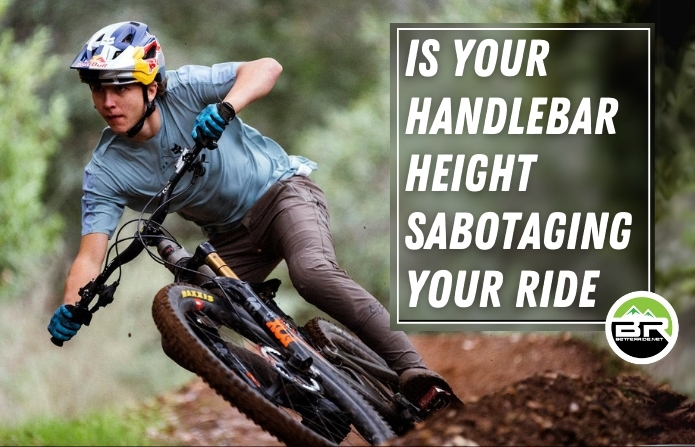
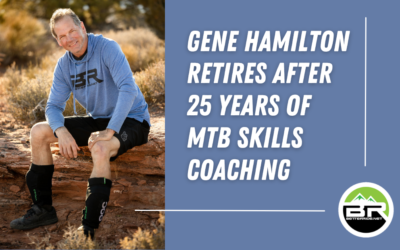
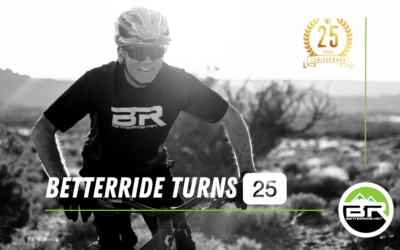
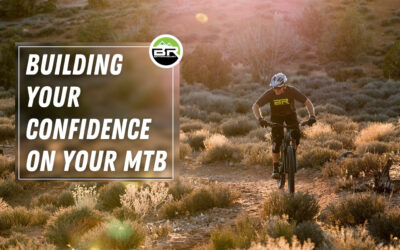
As always, thank you for sharing another great article. I too have been experimenting with bar height and often lean towards a higher rise or stack height. However I have also recently experienced all the benefits you mentioned about riding with a lower bar height.
Thanks, Chris. Glad to hear you are out experimenting!
Great info, Gene. Always amazed at how even millimeter changes can make all the difference. MTB and downhill skiing rely on the same effect, getting over your fall line ski/tire instead of leaning back. Your recommendation can help you get your weighting right.
Thanks, Edward!
Thanks Gene, bars are one of my favourite aspects of bike setup , it’s amazing how much difference a few mm can change the feel and performance.
Hey Jimmy, it really is. Look at Dakotah Nortons setup, he says it’s because he has little crocodile arms! 🙂
Excellent article, been riding since the late 80’s and just got my first full suspension so I am dealing with this issue AND that the BB is about 2” higher than my old bike so leg extensions entered the mix too. Trying to get more extension without having to reach down to my bars.
When I raced in the early 90s, my bars were 3-1/2” below my seat, pushing 60 now, I can’t handle that!
Thanks John.